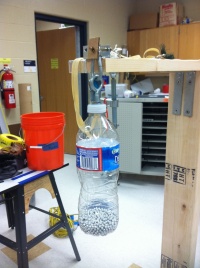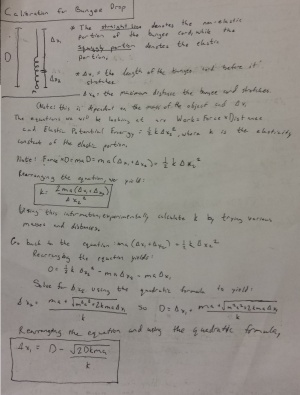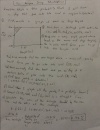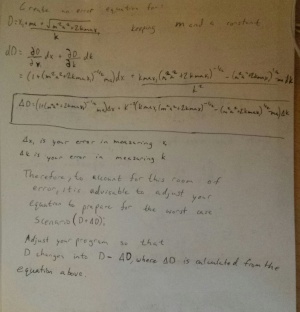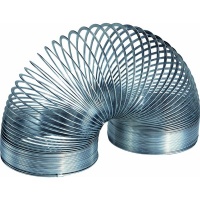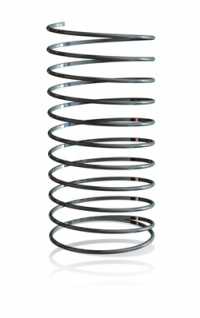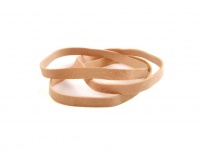Bungee Drop
Cow A Bungee redirects here. For Egg Drop events, see Naked Egg Drop and Rotor Egg Drop.
| Bungee Drop | ||||||
|---|---|---|---|---|---|---|
| Type | Engineering | |||||
| Category | Build | |||||
| Event Information | ||||||
| Latest Appearance | 2015 | |||||
| Forum Threads | ||||||
| ||||||
Bungee Drop is a Division C event last held in the 2015 season. The object is to drop a mass attached to an elastic cord from a given height and to get the mass as close to the ground without letting it touch the ground.
Objective
The object is to drop a mass attached to an elastic cord from a given height and to get the mass as close to the ground without letting it touch the ground. The heights for the two drops can be anywhere from two to five meters (Regionals/States) or ten meters (Nationals), with the same height for both drops (different from 2014 rules). After all devices are impounded impound, both the drop height and object mass will be announced. These weights will be anywhere from 50 to 300 grams and will be placed in a 500-591 mL plastic bottle.
General Advice
Read the event description carefully! The cord can be made from any materials, but the bottom meter must pass the 'elasticity' test. With the 2015 rules for elasticity tests, only the bottom meter of the device needs to be stretch, so the remainder of the cord can be unelastic string. While all sorts of materials can be used to make the cord elastic, ranging from metal springs to Slinkys to elastic or rubber bands, some will be more reliable and will work better.
Practicing
The most important task to be done is calibration. Constructing a device may not be as difficult for Bungee Drop as it is for other events, but practice is key. Since elastic cords are not necessarily consistent in elasticity throughout, it is important to practice with multiple drop heights.
Creating a more reliable testing apparatus will allow you to have better data points to rely on at the competition. A typical bungee testing-device utilizes a soda bottle with mass contained in it and a clamp to hold the cord in place. It is recommended to also have a controlled method of releasing the bottle so that trials are systematic. For an example of a testing apparatus, see the image to the right.
Calibration this year promises to be more complicated than it has been in past years. If, say, you start calibration with a height of 3.00 meters, you can't only find one mark to make on our bungee for that height - you must make a mark for that height with 25 grams, for that height with 50 grams, etc. Getting the same degree of precision as was possible in past years will now, theoretically, take more the time (assuming you calibrate for, say 15 heights, and 15 masses). Of course, the real solution will to be to find a pattern - a formula. With a formula, you can simply input a mass and a height to know how long your cord should be.
A Mathematical Approach
There are many different ways one can tackle the Bungee Drop problem. However, if you want to compete nationally, there really is one approach that trumps all. Math. Math can never break down. 1+1 will never suddenly equal 3 the day before the competition. Math lets you determine the intervals in between. Math is love, math is life.
Partially Elastic Bungee Equations
- Please note: I strongly discourage the usage of partially elastic bungee cords, and instead deeply advocate fully elastic cords, mainly because partially elastic cords deviate from Hooke's law very easily due to higher strain at higher drop heights, while fully elastic bungees retain low strain. However, this section will remain as a reference section for the fully elastic bungees. Furthermore, the fully elastic equation was derived based off the partially elastic equation, so many principles need to be understood here before tackling the fully elastic bungee equations. Finally, if you really want to use the partially elastic equation, here you go.
This formula sheet (courtesy of Joseph Liba (forum name: joiemoie) of Acton-Boxborough Regional High), uses basic physics equations to create the ideal bungee equation. Requirements:
- Your bungee cord has an elastic portion and a non-elastic portion.
- Graphing Calculator
Note: If x₂ is less than the total length of the elastic portion, this k value will be slightly larger than your equation produces. This will only happen in the case of high masses and low drop heights. However, the following calculations indicate that the probability of such an event occurring is rather small and negligible:
Even if this case were to occur in a tournament, it would only bring you slightly further away from tiering. Maybe if you were planning on going about, say 1cm from the ground, instead you'd be going probably 5 cm from the ground.
Calculating the "K" Constant
Use the first equation, [math]\displaystyle{ k=\frac{2ma(x_1+x_2)}{x_2^2} }[/math] to calculate the "k" constant. To make things faster, be sure use an equation that allows you simply input x₁, x₂, and D, where D is not the drop height, but rather distance traveled. A simple way to calculate D is just to get the drop height and subtract how far off the ground it was. I would suggest running as few trials as you can to determine "k".
Also you can just use a force probe, F = kx, and calculate k that way.
K Isn't Perfect. Fix or Doom
As the Wikipedia page notes, "In fact, many materials will noticeably deviate from Hooke's law well before those elastic limits are reached." This is absolutely true. Your bungee's k value won't be constant forever. For example, at roughly 3 meters, our bungee's K value started to go down. This is when you need a NEW EQUATION for k! WOW.
K is really a function of x2, as demonstrated by the following image: [1] (broken link)
Note: K is really just the slope of this graph. Notice how as x2 goes up, at a certain point, k starts to go down. Truly showing k isn't perfect. HOW TO SOLVE: Make a graph of k vs x2. Find an equation. I'm sorry, but there's no magical equation denoting k vs x2. That's the truly experimental part. It may be linear. It may wiggle. Who knows. Now how do you do this? Just use the old equations and calculate a bunch of k values for different x2 values.
The Main Equation
Use the second equation [math]\displaystyle{ x_1=D-\frac{\sqrt{2Dkma}}{k} }[/math]. "x₁" is going to be how long you measure the bungee from the bottom of the ring top of the key ring upwards. Note that D should be the distance from the bottom of the bottle to the floor. The length of the bottle has absolutely zero effect.
Now, what do you do if your k value varied, as denoted by the previous section? Easy! Graphing calculator. Let [math]\displaystyle{ k=f(x_2) }[/math] where f(x2) is some function that you determined earlier. Let [math]\displaystyle{ x_2=\frac{\sqrt{2Df(x_2)ma}}{f(x_2)} }[/math] Use the solve function on your graphing calculator to solve for x2. Let [math]\displaystyle{ x_1=D-x_2 }[/math] Done (Oh, and if you're planning on using the error propagation equations, calculate k and store that somewhere. You'll need it
Error Propagation Equations
This is only if you are going extremely uber-hardcore. This will calculate your predicted error in your equation based on your drop height and mass, and also your error in measurements. This uses some calculus concepts, so just use this equation and shove it into your calculator. Note that this time, the Δx₁ is going to be the error in measuring x₁. Basically means that if you have shaky hands, and think you can only be precise with your measuring tape to half a centimeter, then you would input this as your Δx₁. The Δk would indicate your error in k, which can simply be found by calculating the standard deviation of your k values.
- Note, this is assuming that the testing rig is perfectly measured, so there is no error in D or m. If you have some awful event directing going down, that's quite unfortunate (personal experience).
[math]\displaystyle{ \Delta D=|(1+(m^2a^2+2kmax_1)^{-1/2}ma)|\Delta x_1+|k^{-2}(kmax_1(m^2a^2+2kmax_1)^{-1/2}-(m^2a^2+2kmax_1)^{1/2}-ma)|\Delta k }[/math]
If you are distrustful of your event administration, here's the equation that also takes into account the error in mass and drop height. When I say error in mass, this means like their scale looks pretty shoddy, or is only accurate to say the thousands so you have a +/- .0005 error. Error in drop height means like, say they're just whipping out a ruler and eyeballing the height, and you're pretty sure there's an error of 1cm in the drop height. (personal story. At the MIT invitationals, they tried to use a laser that reflected back to calculate the drop height, and the real drop height was lower than what they said by about .5 meters, so basically almost everyone tiered, and they realized the screwup and asked everyone to retest. However, when they remeasured, they had to do it on the spot and whipped out their lil old ruler, giving an error of about 1cm. Always be prepared for event administration error ;) "
Anyways here's the full on equation for error in D based on error in mass, k, x1, and drop height.
[math]\displaystyle{ \begin{align*}\Delta D&=\left|((2a^2m+2ax_1k)(2(a^2m^2+2ax_1m)^{1/2})^{-1}+a)k^{-1}\right|\Delta m\\&+\left|(1+(m^2a^2+2kmax_1)^{-1/2}ma)\right|\Delta x\\&+\left|k^{-2}(kmax_1(m^2a^2+2kmax_1)^{-1/2}-(m^2a^2+2kmax_1)^{1/2}-ma)\right|\Delta k \\ &+\text{Error in drop height}\end{align*} }[/math]
Accounting for Stretch over Time
Notice as you test your bungee more and more, it'll tend to get less elastic and become longer. This will slightly throw off your "k" value every time you test. How do you compensate for this? Use measuring tape for the non elastic portion of your rope! When your bungee stretches out over time, and becomes less elastic, it will become longer. However, the measuring tape will shift along with the stretch, simulating a constant "k" value.
In summary, use flexible measuring tape attached to the elastic portion of your bungee.
Entirely Elastic Bungee Equations
Please refer to the previous section, except instead of k, we will be using lamda "λ". λ is Young's Modulus of elasticity. λ is a constant. The reason we use λ instead of k compared to the previous section is because in the previous section, we assume that the length of the elastic portion is constant. However, with a bungee that is entirely elastic, the length of the elastic portion is always changing. And the higher up the bungee you go, the more elastic the part under it will be. I mean, think about it logically, too. If you try to stretch a tiny piece of rubber, it's really hard, but if you try to stretch a long piece, it's much easier. λ takes into account the length and the k value at that particular length.
Once again, x1 = length of bungee you're measuring out, x2 is the amount it stretches, D is the distance from floor to bottom of bottle, m is mass, and a is acceleration due to gravity (9.8). Also please remember to use metric. All units are in meters, kilograms, seconds.
All we gotta do is experimentally calculate the λ. [math]\displaystyle{ \lambda=\frac{2max_1(x_1+x_2)}{x_2^2} }[/math]
Keep in mind, λ may not be perfect either, at which point you'll have to find λ as a function of f(x2) as I mentioned in an earlier section.
Cool. You have λ. Now here's the equation that you'll be using at competitions. [math]\displaystyle{ x_1=D+\frac{Dam-D\sqrt{a^2m^2+2am\lambda}}{\lambda} }[/math]
Also, adjust the equation if λ is a function of x2.
Error Equation:
[math]\displaystyle{ \begin{align*}\Delta D&=\left|(a^2mx_1\lambda^{-1}(a^2m^2+2am\lambda)^{-1/2}+ax_1(a^2m^2+2am\lambda)^{-1/2}+ax_1\lambda^{-1})\right|\Delta m \\&+\left|((a^2m^2+2am\lambda)^{1/2}\lambda^{-1}+am\lambda^{-1}+1)\right|\Delta x_1\\&+\left|(amx_1\lambda^{-1}(a^2m^2+am\lambda)^{-1/2}-x_1((a^2m^2+2am\lambda)^{1/2}+am)\lambda^{-2})\right|\Delta k\\&+\text{Error in drop height}\end{align*} }[/math]
Disclaimer: I haven't tested a fully elastic equation yet. So whoever wants to step up and try it out, feel free to be the lab rat, and if it works, remove this disclaimer ;)
Full Elastic vs. Partially Elastic
So now the question is: should you use a fully elastic or partially elastic bungee? What are the pros and cons of both?
Full Elastic: + Slower drop so that the camera is more likely to catch it if it gets close to the ground (one time at a regionals tournament the guy was recording the drops with his iphone that had a 30fps camera and sometimes the bungee dropped so fast that even though it went really close to the ground, the frame only caught the times when it was about 6cm from the ground) + The strain is guaranteed to be roughly constant throughout all drop heights and hooke's law will not break. + Bungee stretches out slower over time, allowing you to do more trials - Can be hard to measure out the x1 if using rubber bands - I haven't tested it yet. - Very good chance that hooke's law will break given high distances. Partially elastic: + Deriving the equation was easier lol + You can use a measuring tape as the non-elastic portion to account for bungee that stretches out over time. -Drops faster so the camera might not catch it
Materials
The 2015 rules allow students to use any materials as long as they pass the 'elasticity' test. While this does give a lot of freedom in deciding how to make your device, obviously some work better than others.
Springs
Springs can be fairly reliable, possibly more reliable than elastic cords. However, they face the issue of tangling during a drop if not positioned correctly. If you decide to use a spring, see which methods of dropping prevent it from tangling. Also, make sure the spring constant is not too large or small (a slinky may not be a good choice because its spring constant is small enough for it to stretch under its own weight.
Rubber
The simplest cord you can make from rubber/latex/etc. is by tying rubber bands together to form a long enough cord, given that it passes the elasticity test. However, depending on how you tie it, the cord may be inconsistently stretch in different parts. This issue can be alleviated if you buy a long enough cord to meet your needs, but even that may be slightly inconsistent (though better).
Competition Tips
- At the competition, always be more cautious for new drop heights. Adjust the cord so that it is slightly shorter than you would expect.
- If the two drop heights are the same, you can adjust the cord for the second drop depending on how close the first drop was.
- If you use graphs to determine a formula, consider adding error bars to your graph so you can predict how careful you should be.
- Some event supervisors will not disclose how close each of your drops was, so consider having your partner stand near the surface to observe how close each drop is.
- The rules permit students to verify the mass of the bottle on their own. Since scales will vary in accuracy, consider using your own scale to measure the mass so that it fits with your data.
Scoring
The goal, as before, is to get the device to drop as close as possible to the floor below, without touching. The team with the lowest score for the sum of the two drops from the ground, wins. However, if one drop hits the surface, a team will be ranked below (Tier 2) all teams that have no touches, and if a team has two touches, it will be ranked below (Tier 3) all teams that had one or no touches.
Tiebreakers are broken in the following order: 1. Single best overall drop; 2. Cord with the greatest elasticity.


